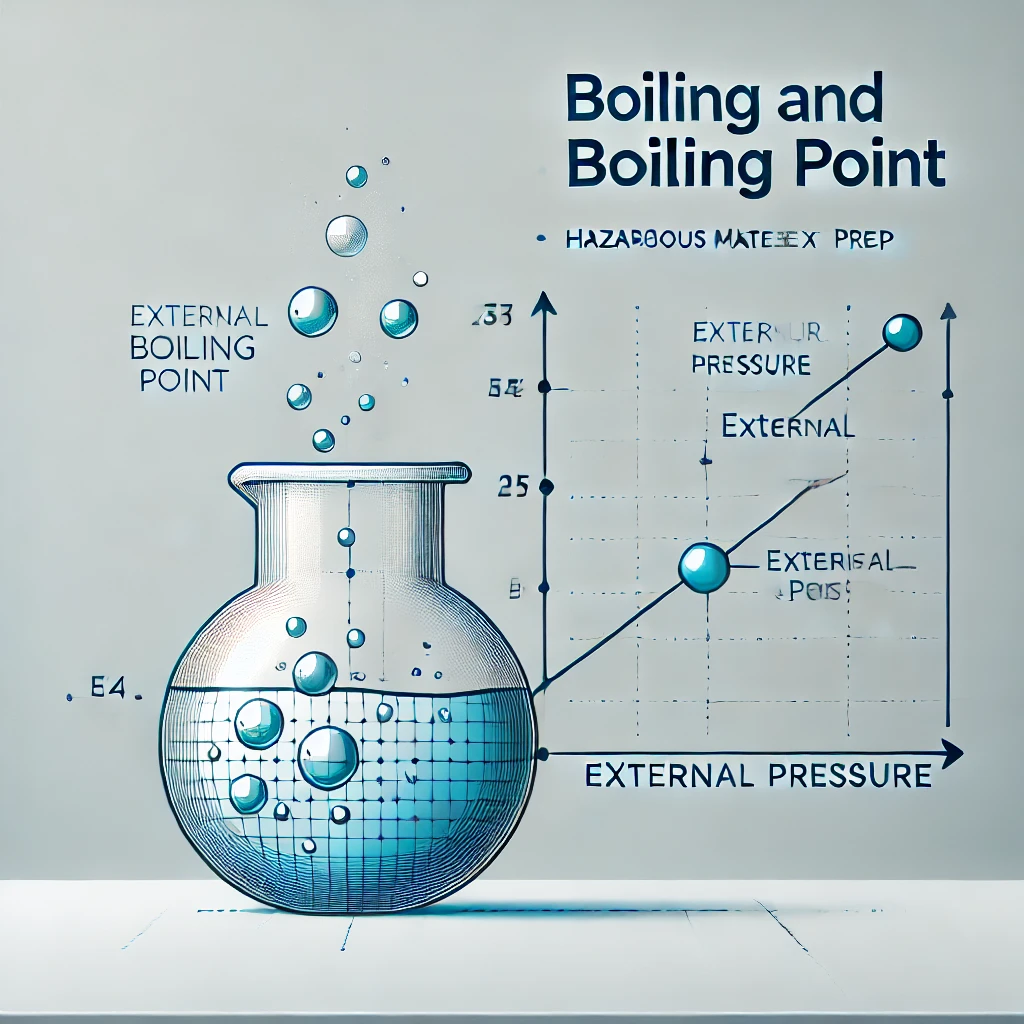Boiling and boiling point of liquids are fundamental concepts in physical chemistry and are crucial for the Hazardous Materials Handler Certification Exam. Especially when dealing with Class 4 hazardous materials (flammable liquids), understanding how differences in boiling points relate to potential hazards is essential. This article explains the mechanism of boiling and the nature of boiling points in detail, providing valuable knowledge for exam preparation.
Basic Concepts of Boiling and Boiling Point
Saturated Vapor Pressure: When a liquid evaporates and becomes a gas, the gas molecules escape from the surface of the liquid. The pressure of the gas when the liquid and gas are in equilibrium at a constant temperature is called “saturated vapor pressure.” As the temperature of the liquid increases, this vapor pressure also increases.
Boiling Point: The boiling point is the temperature at which the saturated vapor pressure of a liquid equals the external pressure (usually atmospheric pressure). In other words, when external pressure is low, the boiling point is also low; when the pressure is high, the boiling point becomes higher.
Relationship Between Boiling Point and Hazardous Materials
Among the classifications of hazardous materials, many Class 4 hazardous materials (flammable liquids) have relatively low boiling points. This means they evaporate easily even at low temperatures, producing flammable vapors. For example, gasoline has a boiling range of approximately 30 to 220°C and can easily evaporate at room temperature, posing a high fire risk. On the other hand, kerosene has a higher boiling point of 150 to 250°C and is less volatile compared to gasoline.
Understanding Boiling and Boiling Point with Everyday Examples
The fact that boiling point changes with external pressure can be observed in everyday life. For instance, in high-altitude mountains where atmospheric pressure is lower, the boiling point of water drops below 100°C. As a result, cooking takes longer because water doesn’t get as hot. In contrast, pressure cookers increase the internal pressure, raising the boiling point of water above 100°C and shortening cooking time.
Key Points for the Exam
Questions related to boiling points frequently appear on the Hazardous Materials Handler Exam. Make sure to understand the following points.
Exam Preparation Points
- Saturated Vapor Pressure and Temperature: As temperature increases, saturated vapor pressure rises. When it equals the external pressure, boiling starts.
- Relationship Between External Pressure and Boiling Point: Lower external pressure results in a lower boiling point, and higher pressure results in a higher boiling point.
- Dangers of Flammable Liquids: Liquids with lower boiling points evaporate more easily and generate more flammable vapors, requiring strict fire safety handling.
- Real-Life Applications: Examples such as pressure cookers and cooking at high altitudes help reinforce understanding of the pressure-boiling point relationship.
Sample Exam Questions
沸点についての説明のうち、誤っているものはどれか?
Which of the following statements about boiling point is incorrect?
(1) 水に不揮発性物質が溶けると、沸点が上昇する。
(2) 沸点の低い物質ほど蒸発しにくい。
(3) 純粋の沸点は、1気圧のとき100℃である。
(4) 液体の蒸気圧が大気圧と等しくなった時、沸騰する 。
(5) 液体の沸点は気圧によって変わる。
(1) When a non-volatile substance dissolves in water, the boiling point increases.
(2) Substances with lower boiling points evaporate less easily.
(3) The boiling point of pure water at 1 atm is 100°C.
(4) Boiling occurs when the vapor pressure of the liquid equals atmospheric pressure.
(5) The boiling point of a liquid varies with air pressure.
Answer: (2) Substances with lower boiling points evaporate more easily.
液体の沸点は、外圧が低いと液体の沸点は高くなる。これは正しいか誤りか?
If the external pressure is low, the boiling point of a liquid becomes higher. Is this statement correct or incorrect?
Answer: Incorrect
Explanation
When external pressure decreases, the boiling point of a liquid also decreases. For example, at high altitudes where atmospheric pressure is lower, water boils below 100°C. Therefore, the statement “If the external pressure is low, the boiling point becomes higher” is incorrect.
Summary
The boiling point of a liquid changes with external pressure, and substances with lower boiling points tend to evaporate more easily. Especially for Class 4 hazardous materials, many of which have low boiling points, proper storage and handling are critical. On the exam, it’s important to understand the relationship between boiling point and pressure, as well as the risks associated with flammable liquids. Use real-life examples to solidify your understanding.



コメント